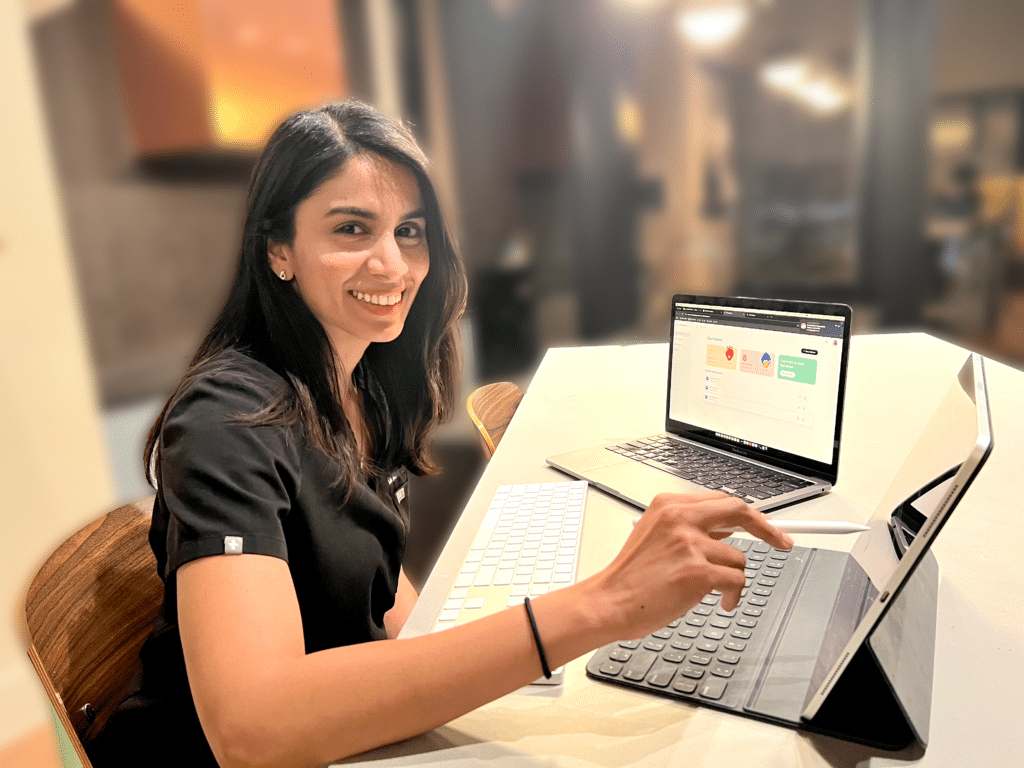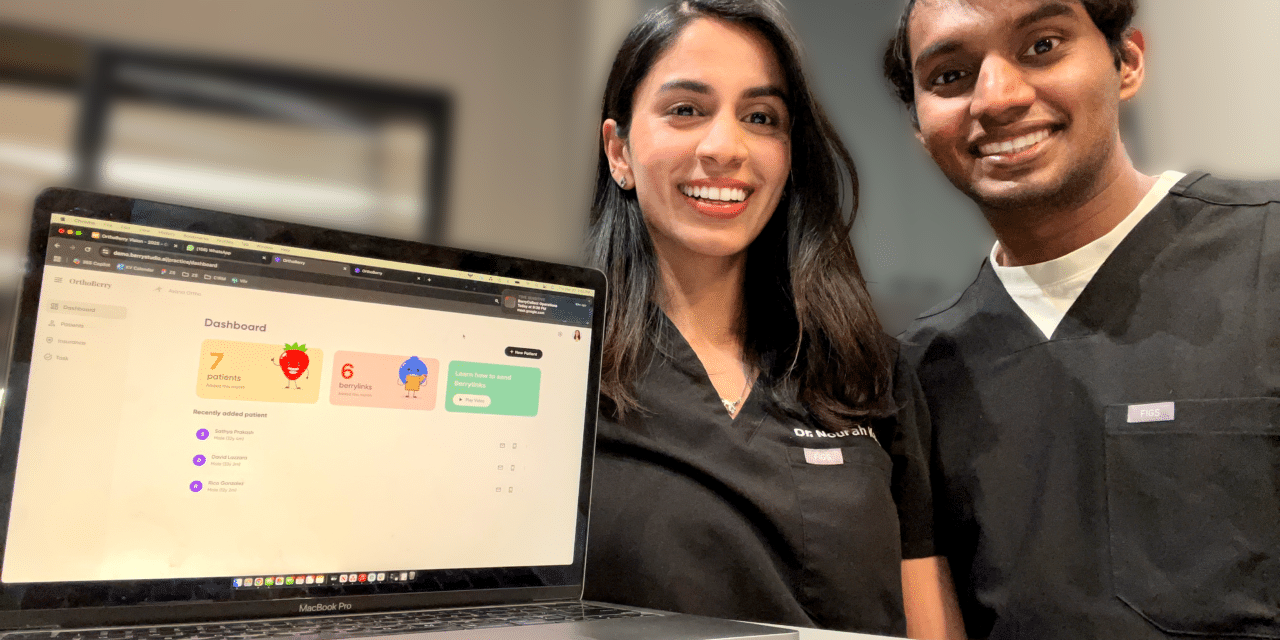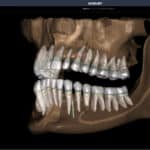The new platform, named the winner of the 2025 AAO Ortho Innovator Award, streamlines patient onboarding and practice workflows by integrating AI-powered tools into a single, user-friendly system.
By Jessie Gainor
Artificial intelligence (AI) is becoming increasingly embedded in the tools and technologies orthodontists use every day. From AI-assisted treatment planning and aligner staging to remote monitoring and clinical documentation, a growing number of companies are introducing machine learning capabilities to streamline both clinical and administrative tasks. The latest entry in this expanding space is OrthoBerry, a platform designed to modernize the patient intake process, which was recently named the winner of the 2025 AAO Ortho Innovator Award.
Developed by Nourah Abdul Kader, DMD, an orthodontic resident at the University of Illinois Chicago, and Karthik Vinayagamoorthi, a practice management consultant and AI-enabled electronic medical records solutions developer, OrthoBerry is a software platform that brings together insurance verification, patient intake forms, call handling, case presentation, patient payments, and task management workflows into a single AI-supported system.
Solving Intake Process Fragmentation
Kader and Vinayagamoorthi began developing OrthoBerry after identifying persistent inefficiencies in the patient intake process—a process that will soon be personal as Kader finishes her residency and goes into private practice. For patients, the experience was often fragmented before they even arrived for their first appointment—multiple phone calls, forms across different platforms, and unclear next steps. For staff, the process required managing a patchwork of disconnected software systems, creating unnecessary administrative work and communication breakdowns. Their goal was to build a single, integrated platform that could deliver a personalized and seamless digital intake experience.
“We actually interviewed 100 patients as a test, and they all said the same thing: ‘I love my doctor, but I don’t like having to call the practice for small things like a receipt; I can’t see where my pre-filled forms are; and I have to log into a portal and find everything on my own,’” says Vinayagamoorthi. “We built this for our own future and thought, we can build this for everyone.”
Streamlining the Staff Experience
For staff, OrthoBerry consolidates tasks that are typically spread across multiple systems, easing the burden of daily administrative work. Instead of switching between platforms for forms, task management, insurance verification, and communication, team members can manage everything within a single interface.
The platform’s AI capabilities further reduce workload by automating common tasks, such as creating to-do lists for new patients, verifying insurance details, and organizing case presentation materials. Conversations and tasks are linked directly to each patient’s chart, improving internal communication and ensuring that key information doesn’t get lost in emails or external messaging apps.
From Call to Case Presentation
One of the primary features of OrthoBerry is its AI-powered call agent, BerryDial, which is designed to handle new patient phone calls either after hours or when front desk staff are unavailable. Unlike traditional automated phone systems that rely on menus and button prompts, BerryDial uses natural language processing to carry out conversational interactions with callers. It can gather key patient details, answer common questions, and verify insurance benefits in real time.
Practices can customize the agent’s responses based on their own protocols, including preferences related to treatment pricing or appointment availability. The platform uses supervised learning to fine-tune the agent’s responses, drawing from real conversations with front desk staff to better reflect the practice’s tone and terminology.
In addition to call handling, OrthoBerry includes an internal task management system called BerryTask, which functions as a centralized workspace for staff. Rather than relying on external tools like Asana or MeisterTask, BerryTask is integrated into the platform and linked directly to each patient’s record. When a new patient enters the system, a workflow is automatically generated, outlining the steps required by staff to move that patient through the intake process. Team members can assign tasks, leave notes, and track progress—all in one place.
Simplifying the Patient Experience
The patient-facing components of the platform aim to simplify and personalize the intake experience. Patients receive a single mobile-friendly link that consolidates everything from digital forms and treatment presentations to payment options and scheduling preferences. The forms are designed to be more user-friendly than traditional PDFs, with pre-filled fields when possible and visual behavioral nudges (in this case, pop-up strawberries) to help users stay engaged. The case presentation tool allows practices to share with the patient treatment plans, educational content, and payment options in an interactive interface. Patients can also complete payment setup, including autopay enrollment, all from their personal device.
A Financial Ledger to Protect Practices
Another key component of the OrthoBerry platform is the financial ledger. Developed with security and transparency in mind, it addresses one of the more vulnerable areas of orthodontic practice operations.
Unlike traditional ledgers, which often allow staff to edit payment entries with minimal oversight, OrthoBerry’s system restricts modifications. Any changes to a patient’s financial plan require the existing payment profile to be closed and a new one created. Each step is time-stamped, producing an audit trail. This structure reduces opportunities for unauthorized edits and makes it easier for practices to track financial adjustments over time. By minimizing manual data entry and creating clearer records, the system aims to limit the potential for internal errors or intentional misuse.
Reducing Software Bloat
In addition to offering greater financial oversight, OrthoBerry reduces the number of third-party software subscriptions a practice needs. Tools for digital forms, task tracking, case presentations, call handling, and ledgers are often purchased separately and operated in silos. OrthoBerry brings these functions under one roof, eliminating the need to toggle between multiple platforms and reducing associated subscription costs.Practices currently using tools like JotForm, Asana, or standalone case presentation or payment software may find that OrthoBerry consolidates those features into a single login, according to Vinayagamoorthi.

A Turning Point for AI
OrthoBerry’s rise comes at a pivotal moment for AI in orthodontics. While AI has long existed in the form of repetitive, rules-based automation—known as agentic AI—it is only recently, with the emergence of generative and inferential AI, that more complex, decision-support tools have become viable for clinical and administrative settings. According to Vinayagamoorthi, this shift has allowed platforms like OrthoBerry to go beyond simple task repetition and begin interpreting practice data to generate useful outputs, such as patient education summaries or treatment letter drafts.
“Now you can have inferential AI use your data and give you the template,” he says, pointing to a key advancement over traditional systems that required manual input at every step. The AAO’s recognition of OrthoBerry with the Ortho Innovator Award, he says, signals growing confidence in the ability of inferential AI to support orthodontic practice management—not just treatment planning.
Staff Support, Not Replacement
This shift in capability also helps address a common concern surrounding AI: job displacement. While automation has prompted anxiety in many industries, the OrthoBerry team says staff responses to their platform have been largely positive. Rather than feeling replaced, staff see the software as a tool that reduces the kinds of repetitive tasks they already dislike and are being outsourced to virtual assistants. OrthoBerry integrates those functions into a single, user-friendly system built specifically for the orthodontic workflow.
“While we look at it and think people might be afraid of it, they actually like that it opens up some of their time so they can spend it talking to patients or working alongside them,” says Kader. The result is a platform that not only reflects where AI is today but also responds to the operational realities of a modern orthodontic practice.
Early Adoption and Onboarding
OrthoBerry is currently being used by a small group of beta practices, with six offices actively using the platform. Its goal is to onboard an additional twelve by June and is actively looking for beta users. As Vinayagamoorthi says, the team is focused on working with digitally forward doctors who are interested in testing and shaping the software as it evolves.
Onboarding takes about a month and involves close collaboration with each practice. The team customizes the platform to fit the office’s workflows—setting up call prompts, forms, and treatment presentations—while also training the AI through supervised learning. By using real conversations and scripts from the practice, the AI adapts to the tone and language of the staff. Once setup is complete, practices fully adopt the system for all new patients, allowing for a smooth transition and immediate integration into daily operations.
Looking Ahead
As AI continues to expand its role in orthodontics, tools like OrthoBerry reflect how the technology is moving beyond clinical applications and into the core operations of practice management. The platform’s recognition by the AAO not only validates its potential but also highlights a broader shift in how practices are thinking about digital infrastructure and patient engagement. For Kader and Vinayagamoorthi, the goal remains rooted in solving everyday problems—streamlining intake, reducing friction for staff and patients, and making complex systems feel simpler. OP
Photos: OrthoBerry
Jessie Gainor is a contributing writer to Orthodontic Products.









